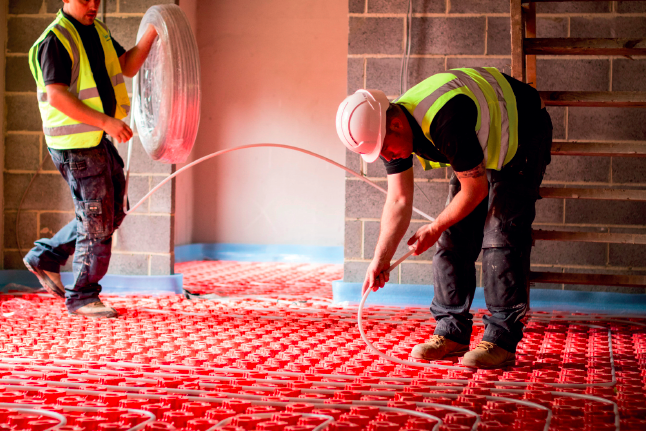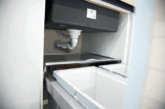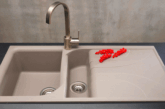
In a competitive housing market, developers are under increasing pressure to offer desirable properties while crucially balancing build costs and delivering future value.
Here, Chris Stammers, Portfolio Manager for BEAMA’s Underfloor Heating (UFH) Group, unpacks the benefits of moving heating systems underfloor to create a tangible point of difference for properties
Despite policy delays, it’s increasingly clear that the need to incorporate low-temperature heating systems into new build and some retrofit plots is here to stay. For housebuilders and developers, this shift in heating systems goes beyond compliance – it’s about future-proofing homes and safeguarding their long-term marketability.
As building standards continue to evolve, installing heating systems today that are efficient, compliant and designed to perform well long into the future is vital. Even on projects where gas boilers remain allowable, there’s a strong case for adopting low-temperature system design now, ensuring homes won’t face costly retrofits as and when any new requirements come into force. One technology that ticks both current and future regulatory boxes, and creates ‘stand out’ in a busy marketplace, is underfloor heating.
By essentially turning the entire floor into a highly efficient heat emitter, UFH enables developers to meet energy targets, free up valuable wall space and deliver true thermal comfort. Plus, as UFH is a naturally low-temperature system, it aligns seamlessly with both heat pumps and gas boiler systems.
Hidden thermal comfort
With new standards incoming and low-flow temperatures already a must, low-carbon ASHPs are becoming a popular solution for both new and retrofit sites. Thanks to the naturally low flow temperatures required by an underfloor heating system, which can be run as low as 30 degrees Celsius, this technology can support air source heat pumps (ASHP) to achieve the highest Coefficient of Performance (CoP) – the ratio between how much energy the heat pump produces and how much electrical energy it consumes.
When paired with an ASHP, an accurately designed and installed underfloor heating system can be up to 40% more efficient and offer lower running costs than a conventional central heating system with radiators, leading to additional cost savings and environmental benefits.
Out of sight and beneath the floor, developers can create sleek, open-plan interiors and position their homes as future-ready in a market where the promise of energy efficiency sells. By its very nature, underfloor heating (UFH) is a truly low-temperature system – and one that many installers are already familiar with. By turning the entire floor of a property into a giant heat emitter, UFH allows installers to deliver the warmth and heat outputs that their customers want, without having to sacrifice wall space to larger radiators or switch to heat pumps before they’re ready.
It also offers significant advantages for existing properties that are being renovated or extended, as it’s straightforward to add UFH to an existing heating system using modern, low-profile and innovative systems.
Designed for performance
The key to success with any UFH installation is to make sure that it is designed correctly, so that whether it is connected to a heat pump or gas boiler, it will always fulfil the needs of the homeowner. That means carrying out accurate heat loss calculations in every room, carefully assessing the floor construction, and checking with the homeowner (or developer, if it is a newbuild property) what floor coverings are being planned, as these can all affect the efficiency of the system.
Then, once the heat losses have been calculated, the installer can make sure the UFH pipe spacings are suitable for the project and consider the supply temperatures and heat losses to make sure the system delivers the required heat outputs.
Many of the BEAMA Underfloor Heating Group members have been designing successful low-temperature heating systems that work at 55°C – and even 45°C – for many years and have thousands of satisfied installers and homeowners to prove that the technology works. It’s crucial to ensure the system is designed correctly for the building involved, and that all relevant heat losses and technical requirements are taken care of so that the system delivers the required heat outputs.
Careful planning at the design stage is critical to the success of any underfloor heating system. An undersized system won’t deliver the comfort levels today’s homebuyers expect, while an oversized solution will compromise efficiency and push up running costs. But when specified correctly, underfloor heating ensures homeowners benefit from a truly efficient, low-temperature system, one that delivers comfort, supports energy performance targets and enhances the long-term value of the property. For housebuilders and developers, it’s an investment that not only strengthens buyer appeal today, but also future-proofs homes ahead of incoming regulatory changes.
BEAMA Underfloor Heating Group is the UK’s national trade association for UFH. Its members can be relied upon to provide quality systems and components backed up with great design, customer service and trustworthy advice.
Visit www.rdr.link/dbg024 to learn more and contact a BEAMA Underfloor Heating Group member.









